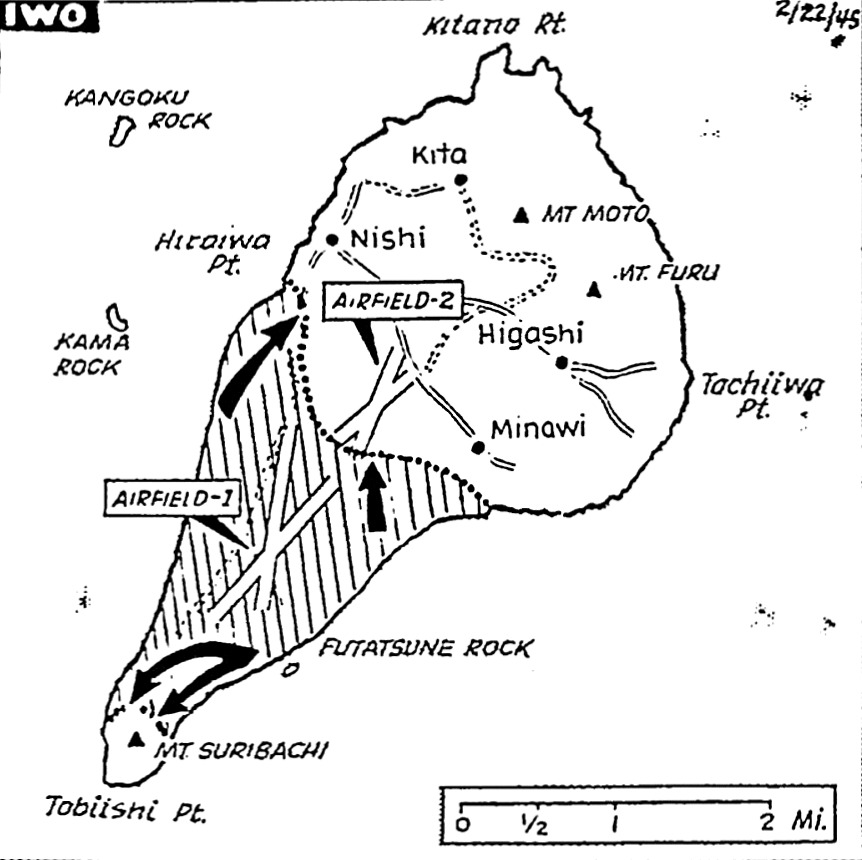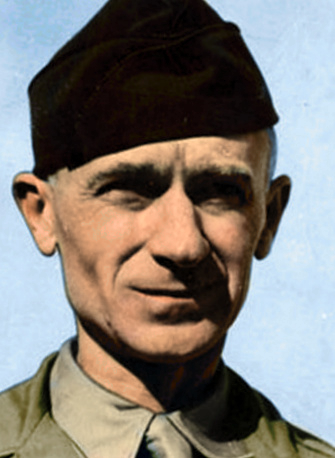Iwo casualties hit 4,553
Reinforced Marines begin new push after stopping Jap attacks
By Frank Tremaine, United Press staff writer

Pledged to take Iwo at any cost, U.S. Marines today launched a new drive toward the No. 2 or central airfield on Iwo after hurling back Jap counterattacks. Other Marines were attacking the Japs on Mt. Suribachi.
ADM. NIMITZ HQ, Guam – U.S. Marines, thinned by 4,553 casualties and then reinforced with a new division, fought in the rain today toward the key airport in the center of Iwo Island.
A communiqué announced that the Marines had launched a new rush toward the Iwo airfield after a stonewall stand against several heavy counterattacks during the night.
**At midday, the Leathernecks were slugging slowly forward through hard rain. They knocked out several Jap gun positions and “generally weakened the airdrome’s defenses,” Guam headquarters announced.
“There was little change in positions of the front line,” Adm. Chester W. Nimitz reported, revealing that counterblows last night had checked the Marine push northward on the island.
With arrival of elements of a third division on Iwo, the biggest Marine force ever thrown into one operation – some 40,000 – was slugging it out toe to toe with the fanatical Jap defenders.
Adm. Nimitz’s communiqué revealed that by 5:45 p.m. yesterday Guam Time (3:45 a.m. yesterday ET), the Marine casualties ashore on Iwo had mounted to an estimated 385 killed and 4,168 wounded.
As of 8 a.m. yesterday, 3,650 Marines were killed, wounded or missing.
The figures indicated more than 900 casualties in one day.
Today, the Marines at the center of the Iwo line attacked northward toward the airport in the center of the island. They breasted heavy fire from small arms, mortars and automatic weapons.
Coupled with repeated counterattacks during the night were incessant Jap attempts to infiltrate the American positions. Adm. Nimitz said that on the line across the island the Marines “successfully resisted the pressure” of the counterattacks.
On the southern end of the island, Marine forces at noon began an assault on the face of Mt. Suribachi, from the heights of which the Japs were shelling the American-held strip across Iwo.
U.S. warships standing off Iwo maintained a steady bombardment of the Jap positions. Naval planes defied rain and other unfavorable weather conditions to support the Marines with heavy bombing, strafing and rocket attacks.
A force of Jap bombers and fighters attacked the ships off the island at sunset yesterday. Adm. Nimitz said they caused “some damage.” Seven Jap planes were shot down by air patrols and anti-aircraft gunners.
“Unloading of supplies is continuing on the beaches under difficulties caused by the loose composition of the volcanic ash shoreline,” the communiqué reported.
Tough, battle-wise Lt. Gen. Holland M. Smith, commander of the expeditionary force, threw elements of a third division into the battle yesterday. Never before in the Marines’ 169-year history have so many divisions fought together in a single operation.
The invasion, entering its fourth day, was proving the toughest of the Pacific campaign. Only a single Jap prisoner has been captured, but more than 850 Jap bodies have been counted. Hundreds more probably were taken away by the enemy.
Tokyo broadcasts set U.S. casualties at 12,000 men killed or wounded up to last night and asserted that a third division had to be brought in because the original two divisions suffered 50 percent losses. The reinforcements were said to have landed from 30 large transports.
Tokyo said:
All units of our garrison force on Iwo Jima simultaneously carried out suicidal attacks beginning at midnight February 20 and all artillery likewise went into action, concentrating cross fire on the massed enemy line and inflicting still greater losses on the enemy.
200 yards from field
Maj. Gen. Clifton B. Cates’ 4th Marine Division fought uphill with tommy guns, bayonets and grenades to within 200 yards of the plateau-top Motoyama Airfield No. 2 in a frontal assault yesterday.
The Marines advanced in the face of almost point-blank machine-gun, mortar and rifle fire poured down on them from Jap positions on commanding heights. Casualties rose steadily, but the advance continued.
The Japs were resisting from steel-shielded foxholes, concrete and steel pillboxes and recessed caves. Many had to be rooted out with bayonets.
Elements of the 5th Marine Division under Maj. Gen. Keller E. Rockey skirted the southern end, of the airfield from the west for a flank attack.
4 tanks knocked out
At the southern end of the beachhead area, other Marines were assaulting the isolated Suribachi volcano with flamethrowers and tanks. Numerous land mines were slowing the advance, and a communiqué conceded that four U.S. tanks had been knocked out in that sector.
The Japs counterattacked east of Suribachi shortly after noon yesterday, but were thrown back. The volcano was studded with gun emplacements, most of which were still in action despite a week of ceaseless air and naval bombardment.
3rd Division in battle
The latest Marine unit to be thrown into battle was the 3rd Marine Division under Maj. Gen. Graves B. Erskine, former chief of staff of Fleet Marine Forces in the Pacific. It received its baptism of fire November 1, 1943, on Bougainville and also spearheaded the liberation of Guam.
A Tokyo broadcast said the “Kamikaze Special Attack Corps” sank two U.S. aircraft carriers and a battleship Monday night off Iwo. Two other warships were said to have been set afire.

